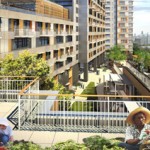In reporting the completion of a new apartment complex in the South Bronx, Via Verde, the New York Times’ Michael Kimmelman has stressed the building’s architectural quality, its accessibility to those of moderate income, and the potentially healthful influences built into the building’s structure. In this last instance, Kimmelman has identified what I have chosen to call “civitas by design,” architectural elements intended to have beneficial effects in solidifying communities of citizens. Not just a fitness center in a prime location, but communal gardens on the roof have been located to enhance both health and sociability. The key, as Kimmelman reports, is what residents do with it. In the 1950s, architects put similar hopes into a new apartment complex in St. Louis, Pruitt-Igoe. Less than twenty years later, as a new film to be screened in November at the Society for American City and Regional Planning History meetings in Baltimore  demonstrates, hopes for the complex turned sour enough to force its demolition. Clearly design was not entirely at fault for Pruitt-Igoe’s fall, but it didn’t serve its residents as intended either. Have we learned in intermediate years how best to capitalize on superior design when serving the poor? Via Verde is worth watching to answer that question.
demonstrates, hopes for the complex turned sour enough to force its demolition. Clearly design was not entirely at fault for Pruitt-Igoe’s fall, but it didn’t serve its residents as intended either. Have we learned in intermediate years how best to capitalize on superior design when serving the poor? Via Verde is worth watching to answer that question.